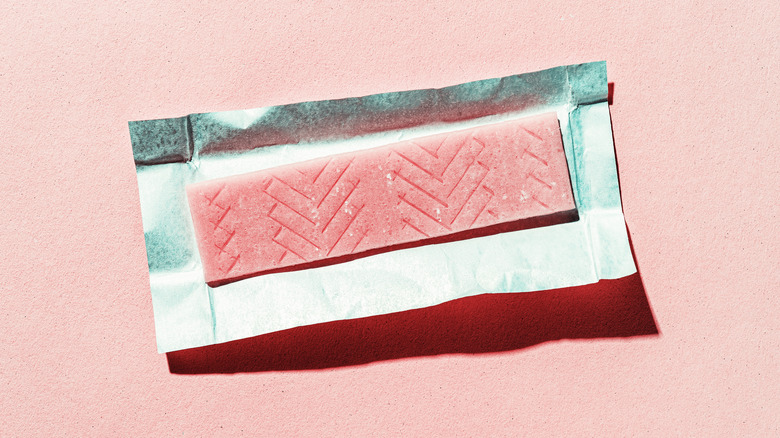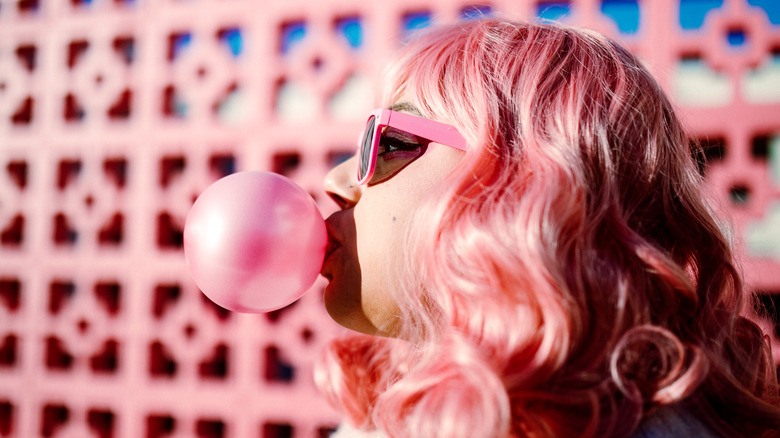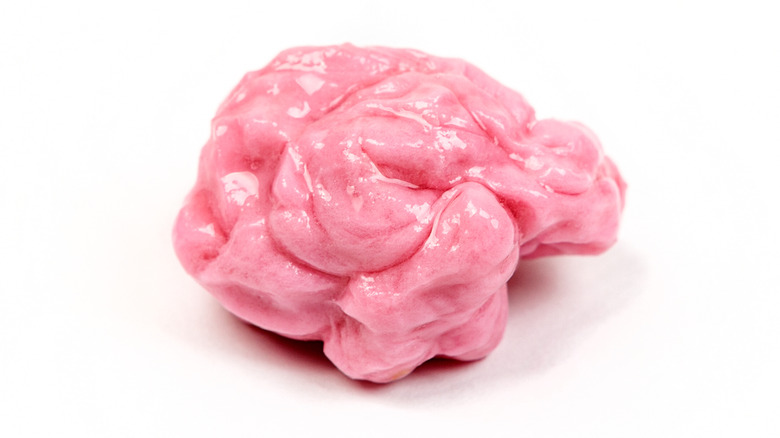We Finally Know How Bubble Gum Got Its Iconic Pink Color
Bubblegum can technically come in a number of colors and flavors, but there's only one hue iconic enough to take the treat's name: Bubblegum pink. Chances are, it's the first color you think of when you think of gum (which, surprisingly, can help you burn some calories), but have you ever stopped to wonder why bubblegum and pink go hand-in-hand? Usually, a candy's color is linked to its flavor, but bubblegum flavor is an enigma of its own. It doesn't taste like anything else, and as it turns out, the taste and color have nothing to do with one another.
Bubblegum being pink was actually the result of pure necessity. Back in 1928, a 24-year-old accountant named Walter Diemer was working for the Fleer Chewing Gum Company, and in his spare time, he enjoyed toying with the company's gum recipes. This hobby paid off in a big way when Diemer struck on the perfect formula for a new chewing gum that was elastic enough to blow bubbles with. There was only one problem; his creation was gray – hardly an appealing shade for candy. So, Diemers went looking for food dye and discovered that Fleer only had one color on hand – a diluted shade of red that turned the grey gum into a pale pink. This color became the standard for every batch of bubble gum that followed.
Bubble gum took decades to perfect
Walter Diemers didn't exactly invent bubble gum from scratch. People have been chewing gum for over 9,000 years, naturally deriving it from tree bark, and plain old chewing gum was popular enough for the Fleer Chewing Gum Company to make a business out of it. However, their founder, Frank Henry Fleer, envisioned bigger possibilities. He wanted to create a type of gum that people could blow bubbles with. It may seem like a silly concept, but the act of blowing bubbles with your gum is more important than you might imagine. Research has shown that engaging in ritualistic behaviors with our food, like folding a slice of pizza or deconstructing an Oreo layer-by-layer, can actually enhance the eating experience.
Fleer's first attempt to make bubble gum came in 1906. He dubbed it Blibber Blubber, but although it was good for blowing bubbles, it was extremely unpleasant to chew. Blibber Blubber managed to be both brittle and sticky, and it did not snap back into the mouth when a bubble popped. Dejected, Fleer shelved the project and never released it to the public. More than two decades later, Diemer added latex to Fleer's original formula and hit on perfection. Not only can we thank the young accountant for bubble gum and its pink color, but he actually invented the flavor, as well.
What in the world is bubble gum flavor?
With the exception of some novelty gum flavors (meatball ... seriously?), most bubblegum has the same taste. We all know it, yet if any of us were challenged to describe it, what could we say? You can't really compare the taste of bubblegum to anything else, and that's actually the point. Bubble gum, like many other confections, is made with flavored chemicals called esters, which are made by combining different types of alcohols and acids in order to mimic natural tastes and aromas. While other manufacturers tried to imitate natural flavors such as grape and cherry in their candy creations, Diemer came up with a new taste, one that combined many different elements to make something unique and different.
Bubblegum was invented with the children's market in mind, so Diemer aimed to create a flavor that kids would love. It also needed to be a long-lasting flavor whose ingredients would not interfere with the delicate chemical composition of the gum. He ultimately went for a combination of multiple fruit flavors, creating the vaguely strawberry-ish, mildly banana-esque flavor we know so well. Today, every company has its own formula, using different ratios of esters, but some type of blend of banana, strawberry, cherry, and citrus is the standard. So, while the pink color came about by coincidence, it actually aligns well with the intended taste. Fleer released their new pink bubble gum under a name you probably know quite well: Dubble Bubble. It remains a hit to this day.


